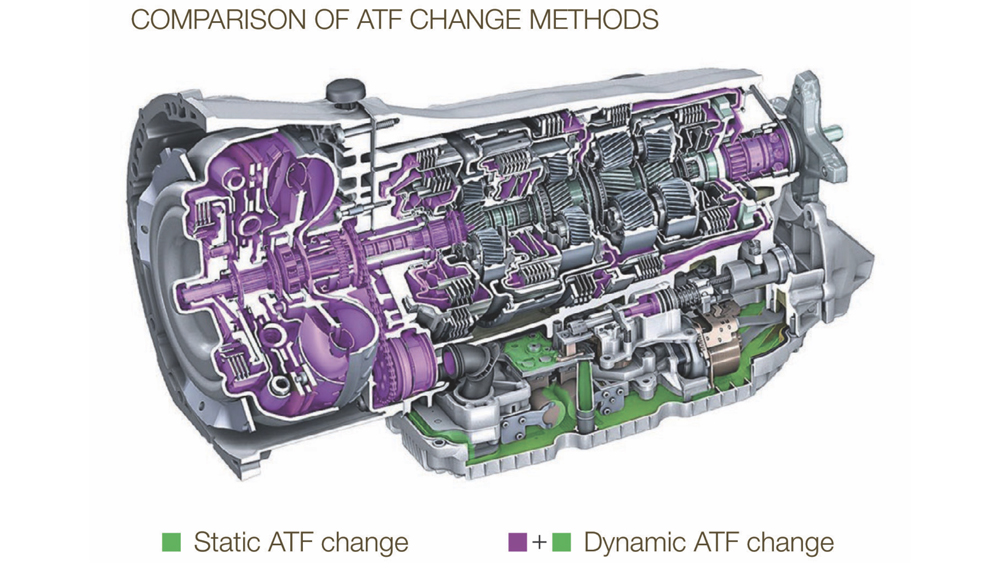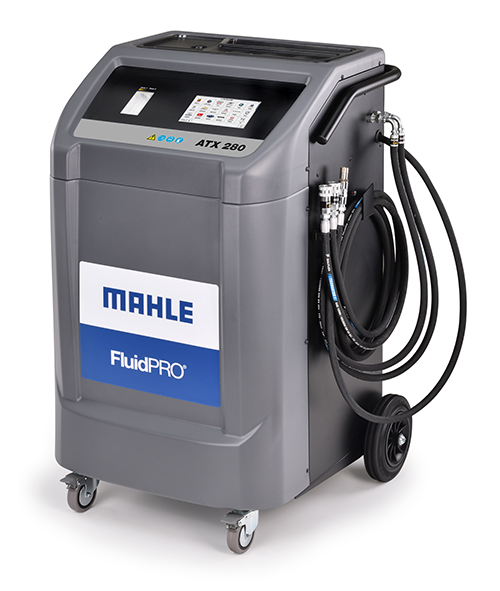The Case for Offering Automatic Transmission Fluid Flushes
More than just a simple drain, dynamic ATF changes make sense for off-road & tow vehicles…

By Brian Messenger
Editor’s note: This article was provided by MAHLE Service Solutions.
Recent industry stats show the average age of passenger vehicles in the United States is a record high of 12.6 years. As drivers keep their cars and trucks on the road longer, experts are projecting improved service opportunities for aftermarket shops.
Among them are automatic transmission fluid (ATF) changes to help prevent transmission wear and tear.
When it comes to ATF changes, a dynamic change—commonly called a “flush”—offers vehicle owners and service shops a comprehensive way to extend transmission life. Before examining what makes dynamic ATF flushes so effective, it’s worth considering what transmission fluid does and why periodic changes are necessary.
ATF Performance Challenges
Transmission fluid plays a critical role in lubricating and cooling the transmission’s internal components. It reduces friction and wear, enabling smooth power transfer while also minimizing the loss of clutch material in each clutch pack.
Transmission fluid is the sole means of dissipating heat for internal transmission components. Without the ability to dissipate heat, a transmission could not survive for long and would require frequent rebuilds.
As transmission fluid absorbs wear material, it loses its ability to cool effectively. It also loses viscosity, which in turn increases the rate at which a transmission heats up. As transmission temperatures rise, the cooling circuit cannot keep up with the required cooling demands. The problem is exacerbated in modern vehicles by the presence of turbochargers, making multiple systems compete for heat exchanger functionality ahead of the powertrain.
All this means today’s transmission fluids must work harder and perform better than ever, which dynamic ATF exchanges enable.
Many shops still consider ATF flushes to be a niche service and have been slow to adopt them. In part, that’s because unlike static, or gravity-assisted ATF changes, dynamic changes require investment in a flush machine, and the service has a reputation of being a lengthier, more involved process.
Additionally, some vehicle manufacturers have traditionally recommended simply topping off ATF levels for the lifetime of the vehicle.
However, due to the presence of turbochargers and tighter automatic transmission tolerances that are less able to accommodate wear material, many transmission manufacturers now recommend periodic ATF changes—generally at 30,000- to 60,000-mile intervals—with heavy towing vehicles recommended more frequently. Additionally, today’s most advanced flush units are more hands-off and user-friendly than ever, putting this profit and relationship-building service within reach for virtually any shop.
The bottom line is that shops that want to keep their service offerings as up-to-date and competitive as possible can consider offering ATF flushes, as they provide a superior preventive maintenance option compared to static changes in almost all situations.
A comparison of static and dynamic ATF changes helps explain why.
Static Vs. Dynamic ATF Changes
A static or gravity-assisted ATF change generally begins with a vehicle test drive to check for issues and to bring the fluid up to operating temperature. To drain the fluid, a technician may either remove just the drain plug or the entire transmission pan for cleaning. If the pan is removed, best practice is to replace the filter and gasket prior to reinstallation.
The key drawback of a static change is that only 30% to 50% of the old ATF is removed and replaced (see illustration below). When new fluid is added, it mixes with the old, leaving 50% to 70% of the contaminated fluid in place.
Meanwhile, a dynamic ATF change or flush also begins with a test drive and a period of engine idling to bring the fluid up to operating temperature. In some newer vehicles, the fluid must get hot enough to trigger the opening of the thermostatic valve. Next, hoses from the flush machine are attached so the unit can pump all (or nearly all) of the old fluid out of the system, including the torque converter and cooler lines.
In sharp contrast to a static change, a dynamic ATF change replaces 90% to 100% of the old fluid. Once the new fluid is added, it won’t mix with any significant volume of old fluid, providing a far more thorough exchange.

Before new ATF is added, the flush unit circulates a cleaning solution to wash contaminants out of the system. As with a static ATF change, the filter and gasket are also replaced.
One note of caution: A dynamic ATF flush dislodges dirt and debris so thoroughly that it should not be performed in certain high-mileage transmissions—namely, those with greater than 100,000 miles that have never undergone a change. In such cases, a flush could cause sludge or debris to get stuck in the valve body, blocking passages or causing valves to stick and not fully seal.
In virtually all other situations, however, a dynamic ATF service is highly effective and offers vehicle owners and service shops a range of benefits.
ATF Flush Service Benefits
Automatic transmission fluid has three jobs: lubricating components to prevent wear, providing hydraulic pressure and friction to keep components moving, and cooling the transmission. As ATF ages with use, it becomes increasingly thin and dirty, limiting how effectively it can do these jobs.
A dynamic ATF change flushes out and replaces nearly all of this spent fluid, almost fully eliminating the risks it poses to the transmission.
For vehicle owners, an ATF flush provides economical preventative maintenance, as it lessens the likelihood of worn parts, blockages and system overheating that could lead to costly repairs. A flush also helps eliminate slipping gears or poor start-up behavior, thereby improving shifting performance and fuel economy.
The service can appeal to drivers of off-road or tow vehicles with automatic transmissions or anyone with a hardworking car or truck that values long-term performance.
For aftermarket shops, offering dynamic ATF changes provides opportunities to build customer trust along with profitability. Promoting and performing flushes positions the shop as knowledgeable and proactive about vehicle care, enhancing its reputation and customer relationships.
ATF flushes also help customers keep their vehicles on the road, making them more likely to return and recommend the shop to others. And because they are performed regularly, flushes can provide both a steady revenue stream and ongoing opportunities to identify other needed products and services for additional revenue.
Ultimately, an ATF flush gives vehicle owners the most comprehensive way to extend transmission life and provides service shops another way to demonstrate their expertise and commitment to vehicle performance.
How They Work

An overview of MAHLE’s ATX ATF Flush product line highlights the efficiency of professional automatic transmission oil servicing. The top-of-the-line model, the FluidPRO ATX 280, features an intuitive touchscreen interface that allows technicians to search a comprehensive transmission database to access 40-plus years of transmission data with step-by-step job instructions and diagrams for every model year.
Once a technician connects the hoses and starts the service, the ATX 280 is fully automatic. It detects fluid flow direction, eliminating the need for an in and out hose and the possibility of human error. Detergents and additives are also injected automatically.
The system also features an automatic temperature monitoring function designed for late-model vehicles with thermostatic valves. The machine indicates when the old fluid reaches operating temperature, then pumps it automatically. As fluid temperature drops with the introduction of new ATF, the unit pauses until the fluid temperature rises and reopens the valve.
The automated features, plus the ability to monitor progress on a phone or tablet using the dedicated app, frees technicians to handle other tasks in the shop. Once the service is complete, all data about the job, including fluid type and amount, is saved and can be shared and printed.
 Brian Messenger
Brian Messenger
Brian Messenger is head of product management, engineering and technical support at MAHLE Service Solutions.



